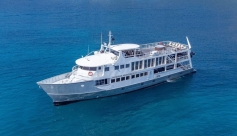Here is a brief summary of the main destinations of Bahamas:
•
Bimini - flushed by the Gulf Stream, large sharks frequent this area – great hammerheads and bull sharks in particular, but also blacktip sharks, blue marlin, wahoo, bluefin tuna. The are a few wrecks, walls, reefs, caverns, blue holes.
•
Eleuthera - off the beaten track, incredible natural beauty, pink sand beaches, ancient coral cays. More wrecks than anywhere else in the country (45), caverns, swim-throughs, tidal holes, rugged deep walls, an unusual abandoned research cage, adrenaline tidal channel drift dive.
•
Exuma Cays - chain of 350 small cays of breathtaking beauty and marine species biodiversity, 2 bodies of water – the shallow Exuma Bank and the deep Exuma Sound. Turtles, eagle and sting rays, and reef sharks and hammerheads. Several blue holes and a couple of wrecks. Superb non-diving activities - swimming pigs, snorkel in hidden caves and grottos or with nurse sharks. Hiking, kayaking, beachcombing.
•
Grand Bahama – Shark capital of Bahamas. The famous Tiger Beach for regular sightings of several tiger sharks, plus hammerheads, lemon sharks, nurse sharks, bull sharks and Caribbean reef sharks. Best opportunities to dive with dolphins, wrecks, coral gardens, caverns and caves.
•
Nassau - the picturesque Lost Blue Hole, shark dives, coral reefs, and drop-offs in to deep oceanic trenches. Many wrecks, several of which have been used in famous Hollywood movies.
Other notable highlights:
Abaco - Shark Rodeo – one of the best shark dives in the Bahamas (Caribbean reef and blacktip sharks), US gunboat wreck, lots of tunnels and caves, plentiful marine reserves.
Andros - highest concentration of blue holes in Blue Hole Nat. Park, 3rd largest barrier reef in world, direct access to Tongue of the Ocean deep water trench for sharks, rays, pelagics, schooling reef fish.
Cat Island - encounters with large congregations of oceanic whitetip sharks that visit as they follow the tuna migration in spring time.
Long Island - second deepest blue hole in the world, British Navy wreck, staggering drop-offs, shark feed dive.









